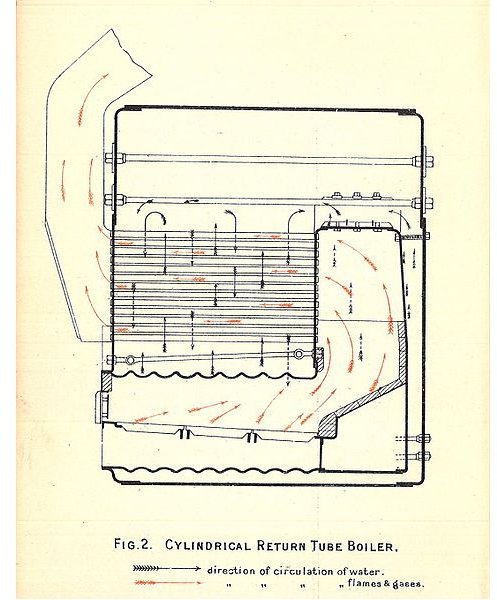Marine Steam Boiler Water Test Procedures, Impuruties and Treatment
Boiler feed water and condensate systems are regularly tested for impurities, which include gasses and undissolved solids. These combine with water properties such as hardness and alkalinity to deposit scale and cause corrosion of water tubes and internal fittings. Any negative results of the tests can be rectified by the addition of chemicals to the feed water and diluting the impurities by blowing down the boiler and adding make up feed.
In the following sections the purpose and equipment used in boiler feed water and condensate testing will be examined. The first section is an overview of the feed system.
Overview
Superheated steam from the boiler is fed into the steam turbine where it expands through the different stages before exiting into the main condenser. This converts any remaining steam to condensate which is fed through the deaerator, and several heaters before being pumped under high pressure back into to the boiler via the main boiler feed valve. The feed water must be regularly monitored for impurities by taking water samples from the different stages in the feed water system which comprises of the make-up water and condensate returns.
Make-up feed being initially supplied by the evaporators, which produce distilled water from seawater.
Testing Techniques
Samples taken from the boiler water feed system are cooled usually to 25οC and tested for the following properties and impurities,
- Dissolved gasses- Oxygen, Carbon Dioxide and ammonia.
- **Acidity or Alkalinity-**Carbonates and bicarbonates Hydroxides content.
- Hardness – Calcium and magnesium salts content
- Undissolved solids – impurities built up in the boiler water over time.
- Chlorine content – usually originates from seawater ingress to feed water system.
Methods of Treatment
- Dissolved gasses of oxygen, and CO2
It is one of the jobs of the deaerator to remove the dissolved gasses in the returning condensate. So if there are consistently high quantities of dissolved gasses in the system it is best to check that the DA is operating correctly.
If however the gasses continue to form, the best method of reducing them is by using a blowdown valve. Some Chief Engineers prefer to leave the boiler on constant blowdown, and I have used this method myself with the provisos,
1. The DA is operating satisfactory
2. The amount of make-up feed is monitored
3. Tests for O2 and CO2 are carried out every watch
4. The steam from the blowdown valve can be used in a feedwater heater.
- Alkalinity
Acid and alkalinity are used to describe properties of fluids, their levels being measured in units of pH from 0 to 14, a pH of 7 being neutral.
Feed water in ships boilers are best maintained at an alkalinity around 8.5pH, as we go below this figure, the acidic water will cause corrosion of the watertubes and internals whereas a reading above will cause excessive coating of scale on these components.
Sodium Phosphate of Soda (NaPo4) can be used to adjust the alkalinity of boiler water.
- Hardness
This is caused by high calcium and magnesium content in the feedwater system. Hardness will cause scaling on the watertubes and internal fittings. It can be controlled by using carbonates, phosphates and certain types of polymers. Carbonates should be used sparingly as they can promote the formation of CO2 with the attendant risk of corrosion.
- Total Dissolved Solids (TDS)
Dissolved solids build up gradually being left behind in the boiler water as impurities.
Strict control of the TDS is imperative as a build-up can cause carry-over of water from the steam drum. This is not only detrimental to the turbines but the sensitive auxiliary equipment and instrumentation and should be avoided at all costs.
- Chlorine Content
This falls into the TDS category but it is worthwhile having a closer look is causes and reduction. A rapid rise in salt PPM indicates a leak of seawater into the feed system, usually from the condenser or process coolers.
Control is achieved again by using the constant blowdown valve and regular topping up of the feed system with make-up feed water.
Testing Procedures
- Testing for Dissolved Oxygen
Indigo Carmine Method
This testing equipment comes in the form of a kit containing all the necessary components to test for dissolved oxygen content.
A phial is provided containing the correct amount of carmine and measured sample of boiler water is added to this, which changes the colour of the mixture. This colour is compared to a colour strip and the corresponding dissolved oxygen content read off.
- Testing for Alkalinity
Years ago we used litmus papers of different pH ranges which were dipped into a filtered solution of feed water. The resultant colour change in the paper, determined whether the sample was acid or alkaline. Not a very accurate method but gave a quick ball-park indication of the condition of the feedwater. Litmus strips are still used but give a more accurate result.
Alkalinity tests are also carried out using an electronic instrument, which consists of a glass probe attached to a meter. The instrument should be calibrated before every test using buffer liquids of known pH.
It operates by immersing the bulbous tip of the glass probe into the feedwater sample, the probe sending a minute voltage through the solution which is measured and displayed on the meter as pH.
Test for Total Dissolved Solids (TDS)
There are several methods to determine the TDS of boiler feedwater, we shall examine one of the more modern methods using a TDS meter.
This instrument works on the principle that dissolved minerals and salts affect the conductivity of a liquid such as boiler feedwater. The instrument measures the waters conductivity and converts the reading to PPM.
References
- McKenziecorp: Boiler Blowdown
- Cip: Boilers and Steam Raising
- Image Credit - http://en.wikipedia.org/wiki/File:Scotch_marine_boiler_side_section_(Stokers_Manual_1912).jpg
- Lenntech: Boiler Feed Water
